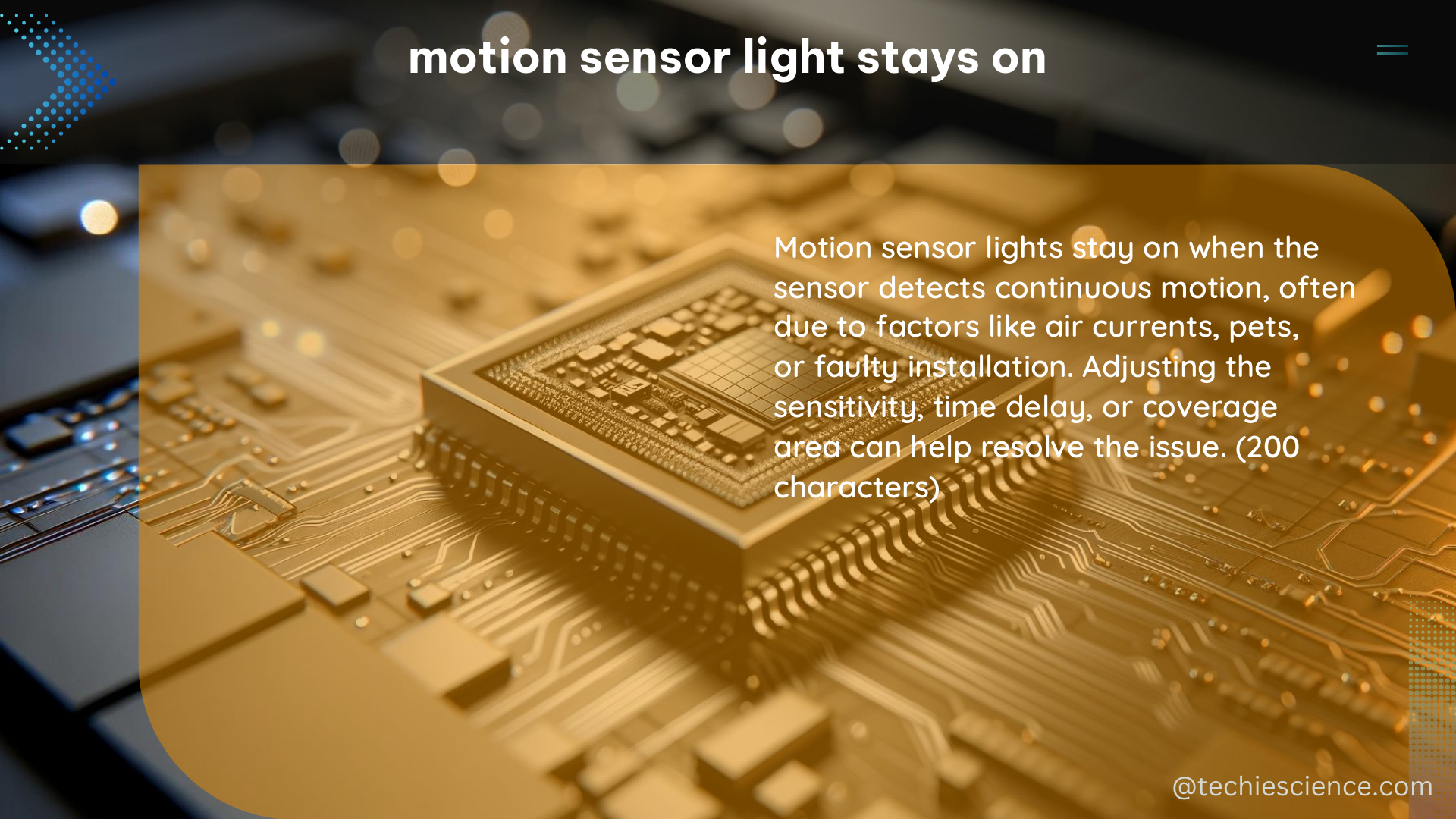Motion sensor lights are a popular choice for outdoor lighting, providing security, convenience, and energy efficiency. However, when these lights stay on continuously, it can be a frustrating and perplexing issue. This comprehensive guide will delve into the technical specifications of motion sensor lights, the factors that can cause them to stay on, and provide a step-by-step DIY troubleshooting approach to resolve the problem.
Technical Specifications of Motion Sensor Lights
Motion sensor lights utilize passive infrared (PIR) technology to detect movement. The key technical specifications that determine the performance of these lights include:
Range
The range of a motion sensor light refers to the distance within which it can detect motion. Typical ranges for motion sensor lights range from 10 to 30 feet, with higher-end models capable of detecting movement up to 70 feet away.
Sensitivity
Sensitivity refers to the sensor’s ability to detect motion. High sensitivity settings can pick up smaller movements, while low sensitivity settings require larger movements to trigger the light. Sensitivity is typically adjustable, allowing users to fine-tune the sensor’s responsiveness.
Time Delay
Time delay is the period the light stays on after detecting motion. Typical time delays range from 30 seconds to 10 minutes, with some models offering adjustable settings to suit different needs.
Factors that Can Cause Motion Sensor Lights to Stay On

There are several reasons why motion sensor lights may stay on continuously, including:
Prolonged Motion Detection
If the sensor continues to detect motion, the light will remain on. This can happen if the sensor is placed in an area with high traffic or if the time delay is set too long, causing the light to stay illuminated even after the initial motion has ceased.
Interference from Other Heat Sources
Other sources of infrared radiation, such as heaters, computers, or televisions, can interfere with the sensor’s ability to accurately detect motion. This can cause the light to stay on even when there is no actual movement.
Faulty Sensor
A malfunctioning or damaged sensor can cause the light to stay on continuously. This could be due to a manufacturing defect or physical damage to the sensor.
Power Supply Issues
Problems with the power supply, such as a low battery or a faulty power source, can also lead to the light staying on indefinitely.
Measurable Data for Troubleshooting
To effectively diagnose and resolve issues with motion sensor lights staying on, it is essential to gather the following measurable data:
- Sensor Range and Sensitivity Settings: Determine the current range and sensitivity settings of the motion sensor and compare them to the manufacturer’s recommendations.
- Time Delay Setting: Verify the time delay setting and ensure it is appropriate for the intended use.
- Ambient Temperature and Humidity: Monitor the temperature and humidity levels in the area where the motion sensor light is installed, as these environmental factors can affect the sensor’s performance.
- Presence of Other Heat Sources: Identify any potential sources of infrared radiation, such as heaters, electronics, or other heat-generating devices, that may be interfering with the sensor.
- Power Supply Voltage and Current: Measure the voltage and current of the power supply to ensure it is within the manufacturer’s specifications.
- Sensor Output Signal: Analyze the sensor’s output signal to determine if it is functioning correctly.
By gathering and analyzing this data, you can pinpoint the root cause of the issue and take appropriate action to resolve the problem.
DIY Solutions for Motion Sensor Light Stays On
If your motion sensor light is staying on, there are several DIY solutions you can try:
- Adjust the Sensor’s Range and Sensitivity Settings: Experiment with different range and sensitivity settings to find the optimal configuration for your specific environment.
- Adjust the Time Delay Setting: Reduce the time delay setting to a shorter duration, which may prevent the light from staying on for an extended period.
- Relocate the Sensor: Move the sensor to a different position to avoid interference from other heat sources or to better cover the desired area.
- Check the Power Supply: Verify the voltage and current of the power supply and replace the battery or power source if necessary.
- Clean the Sensor: Remove any dirt, debris, or obstructions that may be interfering with the sensor’s ability to detect motion accurately.
Remember to always refer to the manufacturer’s instructions and safety guidelines when performing any DIY troubleshooting or maintenance on your motion sensor lights.
Conclusion
Motion sensor lights are a convenient and energy-efficient solution for outdoor lighting, but when they stay on continuously, it can be a frustrating issue. By understanding the technical specifications of these lights and the factors that can cause them to stay on, you can effectively diagnose and resolve the problem using the DIY solutions outlined in this guide. Remember to gather the necessary measurable data and follow the manufacturer’s recommendations to ensure the safe and proper operation of your motion sensor lights.
References
- MIL-STD-881F – DEPARTMENT OF DEFENSE STANDARD PRACTICE – CADE. https://cade.osd.mil/Content/cade/files/coplan/MIL-STD-881F_Final.pdf
- FM 5-0 – Stephen Gates. http://stephengates.com/ADM/FM-JUL22.pdf
- I got in trouble for using a mouse jiggler … despite my excellent work – Ask a Manager. https://www.askamanager.org/2023/01/i-got-in-trouble-for-using-a-mouse-jiggler-despite-my-excellent-work.html

The lambdageeks.com Core SME Team is a group of experienced subject matter experts from diverse scientific and technical fields including Physics, Chemistry, Technology,Electronics & Electrical Engineering, Automotive, Mechanical Engineering. Our team collaborates to create high-quality, well-researched articles on a wide range of science and technology topics for the lambdageeks.com website.
All Our Senior SME are having more than 7 Years of experience in the respective fields . They are either Working Industry Professionals or assocaited With different Universities. Refer Our Authors Page to get to know About our Core SMEs.